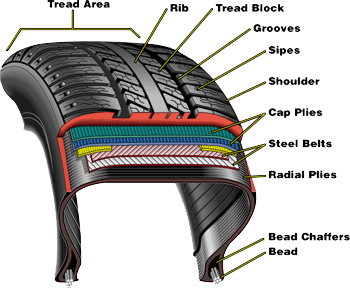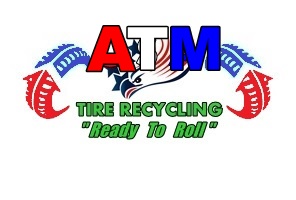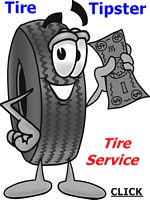Click Here for the “Tire Man’s Bible” on Basic Tire Service, Replacements, Repairs and Conditions or everything you thought you knew or wanted to know about used tires to professionally build and expand your business
Tire Guide Reference The tire size branded on the sidewall provides a significant amount of information about the tire's intended purpose, dimensions, load capacity and high temperature/high speed durability.
Our primary example will be based on variations of the 225/50R16 size, although other sizes will appear where appropriate.
Service Type
Most tire sizes begin with a letter or letters that identify the type of vehicle and/or type of service for which they were designed. The common indicators are as follows:
P225/50R16 91S
P = When a tire size begins with a "P," it signifies the tire is a "P-metric" size that was designed to be fitted on vehicles that are primarily used as passenger vehicles. This includes cars, minivans, sport utility vehicles and light duty pickup trucks (typically 1/4- and 1/2-ton load capacity). The use of P-metric sizes began in the late 1970s and they are the most frequently used type of tire size today.
225/50R16 92S
If there isn't a letter preceding the three-digit numeric portion of a tire size, it signifies the tire is a "Metric" size (also called "Euro-metric" because these sizes originated in Europe). While Metric tire sizes are primarily used on European cars, they are also used on vans and sport utility vehicles. Euro-metric sizes are dimensionally equivalent to P-metric sizes, but typically differ subtly in load carrying capabilities.
T125/90D16 98M
T = If a tire size begins with a "T," it signifies the tire is a "Temporary Spare" ("space saver" or "mini spare") that was designed to be used temporarily only until a flat tire can be repaired or replaced.
LT245/75R16 108/104S
LT = If a tire size begins with "LT," it signifies the tire is a "Light Truck-metric" size that was designed to be used on vehicles that are capable of carrying heavy cargo or towing large trailers. This includes medium and heavy-duty (typically 3/4- and 1-ton load capacity) pickup trucks, sport utility vehicles and full-size vans. Tires branded with the "LT" designation are the "little brothers" of 18-wheel tractor-trailer tires and are designed to provide substantial reserve capacity to accept the additional stresses of carrying heavy cargo.
7.50R16LT 112/107Q, 8.75R16.5LT 104/100Q or 31x10.50R15LT 109Q
LT = If a tire ends with "LT," it signifies the tire is either an earlier "Numeric", "Wide Base" or "Flotation" Light Truck size designed to be used on vehicles that are capable of carrying heavy cargo and towing trailers (Numeric sizes), use 16.5-inch diameter rims (Wide Base sizes) or are wider, oversized tires designed to help the vehicle drive on top of loose dirt or sandy surfaces (Flotation sizes). This includes light, medium and heavy duty (typically 1/2-, 3/4 and 1-ton load capacity) pickup trucks and sport utility vehicles. Tires branded with the "LT" at the end of their size designation are also the "little brothers" of 18-wheel tractor-trailer tires and are designed to provide substantial reserve capacity to accept the additional stresses of carrying heavy cargo.
195/70R15C 104/102R
C = If a Euro-metric sized tire ends with a "C," it signifies the tire is a "Commercial" tire intended to be used on vans or delivery trucks that are capable of carrying heavy loads. In addition to being branded with the "C" in their size, these tires are also branded with their appropriate Service Description and "Load Range" (Load Range B, Load Range C or Load Range D).
ST225/75R15
ST = If a tire size begins with "ST," it signifies the tire is a "Special Trailer Service" size that was designed to only be used on boat, car or utility trailers. ST-sized tires should never be used on cars, vans or light trucks.
Section Width
Following the letter(s) that identify the type of vehicle and/or type of service for which the tire was designed, the three-digit numeric portion identifies the tire's "Section Width" (cross section) in millimeters.
P225/60R16 97H

The 225 indicates this tire is 225 millimeters across from the widest point of its outer sidewall to the widest point of its inner sidewall when mounted and measured on a specified width wheel. This measurement is also referred to as the tire's section width. Because many people think of measurements in inches, the 225mm can be converted to inches by dividing the section width in millimeters by 25.4 (the number of millimeters per inch).
225mm / 25.4 = 8.86"
Sidewall Aspect Ratio
Typically following the three digits identifying the tire's Section Width in millimeters is a two-digit number that identifies the tire's profile or aspect ratio.
P225/60R16 97H
The 60 indicates that this tire size's sidewall height (from rim to tread) is 50% of its section width. The measurement is the tire's section height, and also referred to as the tire's series, profile or aspect ratio. The higher the number, the taller the sidewall; the lower the number, the lower the sidewall. We know that this tire size's section width is 225mm and that its section height is 50% of 225mm. By converting the 225mm to inches (225 / 25.4 = 8.86") and multiplying it by 50% (.50) we confirm that this tire size results in a tire section height of 4.43". If this tire were a P225/70R16 size, our calculation would confirm that the size would result in a section height of 6.20", approximately a 1.8-inch taller sidewall.
Internal Construction

A letter (R in this case) that identifies the tire's internal construction follows the two digits used to identify the aspect ratio.
P225/60R16, P225/60ZR16
The R in the P225/60R16 97S size identifies that the tire has a Radial construction in which the tire's body plies "radiate" out from the imaginary center of the wheel. Radial tires are by far the most popular type of tire today representing over 98% of all tires sold.
If the R in the size was replaced with a D (225/60D16), it would identify that the internal tire body plies crisscross on a Diagonal and that the tire has a "bias ply" construction. Tires using this construction are for light truck and spare tire applications.
If the R in the size was replaced with a B (225/60B16), it would identify that the tire body plies not only crisscross the tire on a diagonal as before, but that they are reinforced with belts under the tread area. This type of tire construction is called "Belted." Tires using this construction are practically extinct.
The European Tyre and Rim Technical Organisation (ETRTO) has adopted branding standards that allowed tire manufacturers to identify tires with self-supporting run-flat constructions within the tire size designation. Self-supporting run-flat tires may be identified with the letter F immediately following the traditional letter identifying tire construction (such as the R designating radial) within the size.
This results in size designations such as 225/45RF17 91Y (for self-supporting run-flat tires that have a speed rating identified in their Service Description and 255/40ZRF20 (for Z-speed rated self-supporting run-flat tires in which the speed rating is contained in the tire size).
Since this tire size designation was adopted well after the introduction of self-supporting run-flat tires into the marketplace, self-supporting run-flat tires introduced and produced before it went into effect will not be required to be branded as such.
Speed Rating
Today, the only tires that continue to include the speed rating "in" the tire size (P225/60ZR16) are Z-speed rated tires. In this case, following the two digits used to identify the aspect ratio are the letters ZR to identify the tire's speed rating (Z) and its internal construction (R). Since 1991, all other speed ratings are identified in the tire's Service Description (which will be covered shortly).
Tire and Wheel Diameter
P225/50R16 91S
The 16 indicates the tire and wheel diameter designed to be matched together.
Tires that have a rim diameter expressed in inches (P225/50R16, as well as 8, 10, 12, 13, 14, 15, 17, 18, 19, 20, 22, 23, 24, 26 and 28) are called "inch rim" sizes, are the most common type of tire size and are used on most cars, minivans, vans, sport utility vehicles and light duty light trucks.
While not as common, two additional "unique" types of tire/wheel diameters are still in use today.
Tires and wheels that have a rim diameter expressed in "half" inches (8.00R16.5LT, as well as, 14.5, 15.5, 17.5 and 19.5) are used on some heavy-duty trailers, heavy-duty light trucks and box vans.
Tires and wheels that have a rim diameter expressed in millimeters (190/65R390, as well as, 365 and 415) are called millimetric sizes. Michelin initiated millimetric sizes for their TRX tires that saw limited use on many different car models in the late 1970s and 1980s.
Michelin PAX System run-flat tires have been introduced as an integrated wheel/tire system on a very limited basis as Original Equipment (O.E.) in North America. An example PAX System size of 235/710R460A 104T expresses tire and wheel dimensions in millimeters (235 mm Section Width, tire Overall Diameter of 710 mm and a 460A mm rim diameter, with the "A" in 460A signifying these tires feature "asymmetric" beads in which the outside bead (450 mm) and inside bead (470 mm) are actually different diameters.
All of these "unique" tire/wheel diameters were developed specifically because the tire and wheel design or intended vehicle use required them to be different than conventional tires and wheels. All of these tires and wheels feature bead profiles that have a different shape than traditional "inch rim" sizes.
Tires and wheels with unique rim diameters should never be combined with traditional "inch rim" tires and wheels.
It is critical that the tire and wheel diameters are always confirmed to match before the tire is mounted on the wheel.
Service Description
P225/50R16 91S
The 91S represents the tire's Service Description. A Service Description identifies the tire's Load Index and Speed Rating. Service Descriptions are required on all speed rated (except for Z-speed rated) tires manufactured since 1991.
Tire Size Markings
The tire size shown below is P185/60R14 82H. The P
represents the car type, Passenger. The 185 represents its section
width (tire width in mm). The 60 is the tires Aspect Ratio (the
ratio of the sidewall height to the tread width). The R represents
radial tire construction. The 14 represents the rim/wheel size
and 82H represents the load index and speed symbol.





 INFORMATION LINKS
INFORMATION LINKS

